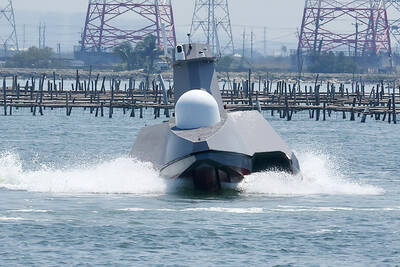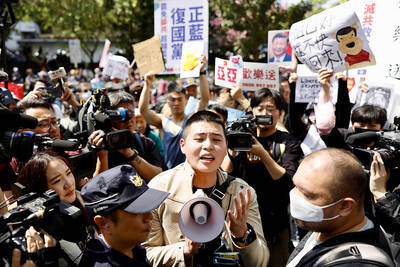President Ma Ying-jeou (馬英九) yesterday promised to make good on his campaign promises, stressing that if a comprehensive economic cooperation agreement were signed between the two sides of the Taiwan Strait, there would be no influx of Chinese workers, imports of agricultural products from China would not increase and Chinese students would not be permitted to obtain professional licenses in Taiwan.
Ma made the remarks in an interview with the Taipei Times.
While it was important to normalize the nation’s trade and economic relationship with China, normalization did not necessarily mean allowing Chinese workers or more Chinese agricultural products to enter the domestic market, nor would Chinese students be permitted to sit national examinations to obtain professional licenses, Ma said.
As the ASEAN Plus One cooperation framework is set to take effect soon, Ma said it was important to ink a comprehensive economic cooperation agreement with China, but promised to take the interests of domestic industries into consideration should such a pact be signed.
The president said his administration welcomed suggestions concerning the content of the pact and its format, but ruled out holding a referendum to solicit public consensus on the issue.
“A referendum is one option, but it is not the only option,” he said. “It is time-consuming and expensive.”
Ma said that a referendum would cost an estimated NT$300 million (US$8.8 million) to NT$500 million, and also take time to publicize.
More importantly, he said, the thresholds for a referendum are so high that not many referendums had succeeded in the past.
“If the government were to hold a referendum to decide every major policy, it would be very hard for the government to operate,” he said.
“We simply cannot hold a referendum because some people are against a government initiative,” Ma said.
Opinion polls might be a better solution, as long as they were conducted in a modern and scientific manner, Ma said.
More than one opinion poll would have to be conducted by different institutions over a period of time, he said.
Once a cooperation agreement with China has been signed, Ma said, it should proceed to the legislature for approval.
Article 5 of the Act Governing Relations between the Peoples of the Taiwan Area and the Mainland Area (台灣地區與大陸地區人民關係條例) states that all treaties that require legal revision or legislation must be reviewed by the legislature. Those that do not require revision or legislation must be ratified by the legislature.
Ma said he had no problem inking the agreement under the “one China” framework, because “one China” refers to the Republic of China (ROC), the official title of Taiwan.
Asked whether his interpretation conformed to the international reality, Ma said: “If we do not interpret it this way, do you think we should say the ‘one China’ refers to the People’s Republic of China?”
That is the only interpretation according to the ROC Constitution, he said.
Asked whether the ROC Constitution was still suitable for Taiwan, Ma said: “Of course it is,” adding that it had been amended seven times and there was no doubt that the ROC Constitution cannot be implemented in China.
However, Ma acknowledged that not many countries felt the same way.
“As long as there are 23 countries that recognize us, and we also have substantive ties with other countries, we can survive,” he said.
Ma denied that Taiwan’s sovereignty may have been compromised when agreements were signed with Beijing last year, implying that no supplementary plans needed to be made when negotiating with Beijing on the economic pact.
He also dismissed the claim that Beijing’s diplomatic partners consider Taiwan to be part of China because they tend to say they “acknowledge,” “take note of” or “understand and respect” China’s claim, but never say they accept Taiwan’s sovereignty.
“Although they do not recognize us, they do not deny our existence either,” he said. “Our survival does not depend on changing the name of the country, but on our might and competitiveness.”
Editor’s note: The full content of the interview will be published tomorrow.

ENDEAVOR MANTA: The ship is programmed to automatically return to its designated home port and would self-destruct if seized by another party The Endeavor Manta, Taiwan’s first military-specification uncrewed surface vehicle (USV) tailor-made to operate in the Taiwan Strait in a bid to bolster the nation’s asymmetric combat capabilities made its first appearance at Kaohsiung’s Singda Harbor yesterday. Taking inspiration from Ukraine’s navy, which is using USVs to force Russia’s Black Sea fleet to take shelter within its own ports, CSBC Taiwan (台灣國際造船) established a research and development unit on USVs last year, CSBC chairman Huang Cheng-hung (黃正弘) said. With the exception of the satellite guidance system and the outboard motors — which were purchased from foreign companies that were not affiliated with Chinese-funded

PERMIT REVOKED: The influencer at a news conference said the National Immigration Agency was infringing on human rights and persecuting Chinese spouses Chinese influencer “Yaya in Taiwan” (亞亞在台灣) yesterday evening voluntarily left Taiwan, despite saying yesterday morning that she had “no intention” of leaving after her residence permit was revoked over her comments on Taiwan being “unified” with China by military force. The Ministry of the Interior yesterday had said that it could forcibly deport the influencer at midnight, but was considering taking a more flexible approach and beginning procedures this morning. The influencer, whose given name is Liu Zhenya (劉振亞), departed on a 8:45pm flight from Taipei International Airport (Songshan airport) to Fuzhou, China. Liu held a news conference at the airport at 7pm,

AIR SUPPORT: The Ministry of National Defense thanked the US for the delivery, adding that it was an indicator of the White House’s commitment to the Taiwan Relations Act Deputy Minister of National Defense Po Horng-huei (柏鴻輝) and Representative to the US Alexander Yui on Friday attended a delivery ceremony for the first of Taiwan’s long-awaited 66 F-16C/D Block 70 jets at a Lockheed Martin Corp factory in Greenville, South Carolina. “We are so proud to be the global home of the F-16 and to support Taiwan’s air defense capabilities,” US Representative William Timmons wrote on X, alongside a photograph of Taiwanese and US officials at the event. The F-16C/D Block 70 jets Taiwan ordered have the same capabilities as aircraft that had been upgraded to F-16Vs. The batch of Lockheed Martin

GRIDLOCK: The National Fire Agency’s Special Search and Rescue team is on standby to travel to the countries to help out with the rescue effort A powerful earthquake rocked Myanmar and neighboring Thailand yesterday, killing at least three people in Bangkok and burying dozens when a high-rise building under construction collapsed. Footage shared on social media from Myanmar’s second-largest city showed widespread destruction, raising fears that many were trapped under the rubble or killed. The magnitude 7.7 earthquake, with an epicenter near Mandalay in Myanmar, struck at midday and was followed by a strong magnitude 6.4 aftershock. The extent of death, injury and destruction — especially in Myanmar, which is embroiled in a civil war and where information is tightly controlled at the best of times —